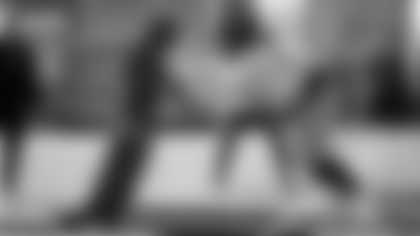When Executive Vice President of Football Operations/General Manager John Elway and the Broncos decide on a pick in the 2017 NFL Draft, the process isn't over. There's still a phone call to make before the commissioner or another NFL representative announces the selection. Who is on the other side of that phone call? Who writes the pick's name on a blank card and submits it to the league? Who *officially *finalizes the draft selection process? We spoke to Kirk Dyer, executive director of ticket operations and admin, who will write the names down for the 15th consecutive year. He filled us in on what *really *happens at the NFL Draft and about the process that makes prospects into Denver Broncos.
Aric DiLalla: When did you first start serving as the team representative, and what's the process like?
**
Kirk Dyer:** I first got tapped for it back in 2003 by Ted Sundquist, when he was general manager here. And I've just been doing it ever since.
Basically, the process is that [Director of Corporate Partnerships] Derek [Thomas] and I will go there, and we'll get out there a day before just to make sure we're there in time. We'll head over to the facility. About two-and-a-half hours before the draft starts, we do have a meeting with all the other teams just to go over procedures and policies. Because so many of these people are the same people, it's actually a real quick meeting. Everybody knows what the drill is.
Once we get ready to start, then the team at Dove Valley will call us at the table. We'll be on the phone with them during the entire draft. Obviously with the crowd noise and everything else, we just keep it on mute. And they may mute it in their office, but with John [Elway], it really hasn't been that way. We've been able to hear a little bit going on. Then as we get on the clock, we'll let them know we're on the clock. We know as soon as the [previous] pick goes in. We'll just let them know, 'Hey, we're on the clock now.' And then at some point during that, then they'll let us know what the pick is, we'll write it down and turn it in.
AD: Who do you give the picks to?
KD: There's actually runners that come to each table. During the first round, there are two runners, and both of those runners will be at the table for whoever is on the clock. Once that pick is turned in, one of those runners runs it to the dais in front, and the other runner will go to the next pick's table, inform them who the pick is, and then once the [first] guy has dropped the card off, he'll come and join the runner at the [next] table. And then as you get into the later rounds where you've got less time on the clock, they do have multiple sets of runners.
**
AD: And that system would be the same for each of the 32 teams, right?**
KD:Yes, everybody is the same. All 32 tables are right there. A lot of times what we'll do is we'll watch to see what's going on, and we can inform the guys here whether or not a trade is taking place. [NFL Vice President of Player Personnel] Ken Fiore, will be up at the head table, and when those guys get on the phone, you can tell something is up and that somebody is calling in a trade. And both teams have to call in a trade. It can't just be one team. So when there are two guys on the phone, we know something is up. You try to figure it out, who it is, and then inform the guys in our war room who the trade is between. Because then we'll watch the runners and see where the runners go. They'll leave the table that's on the clock and move to the team that they traded with.
AD: How do the actual logistics of the room work? Is the Broncos' table in the same place every year?
KD: The table's not always in the same place. It really depends on what the draft order is. It's funny, because I've actually tried to figure [the setup] out. The only thing I can tell you with certainty, is the team that has the No. 1 overall pick is on the far left in the front row, and the team that won the Super Bowl is on the far right in the front row. Those are the only two that I can figure out as far as rhyme or reason to why they're there. There are some years we've been in the front row, some in the second row, some in the last row. … We don't find out till we get there. We look for the helmet.
AD: How have your emotions during the draft changed since 2003?
KD: It was funny, during our very first one: I was nervous. Now it's just become such a routine for us. The guys in the war room are real good at keeping us informed, so it's just basically doing our job.
**
AD:Picking Von Miller with the second-overall pick must've been a little different, though. What was it like to be part of that franchise-changing moment?**
KD: That was a lot of fun. That was a lot of fun, and that was the earliest we had ever picked, with the second-overall pick. That was kind of a little nerve wracking just because … all eyes are on you at that point, because it is the No. 2 pick. But yeah, it is kind of neat to know I'm the one who wrote Von's card out and turned it in.
AD: Besides that Miller pick, were there any other instances that stood out as hectic or unique?
KD: There was one my very first year and it was when Minnesota let the time run out on their pick. And I think it was Baltimore and Jacksonville who got their picks in right away and then Minnesota got their pick in. And I'll never forget [current College Scouting Coordinator] Dave Bratten coming on the phone and saying, 'Hey guys, your day probably just got about an hour shorter,' because back then I think it was 15 minutes for the first-round pick.
AD: How do you pass the time during the hours between our picks?
KD: You're on the phone with them the whole time. You're kind of relaying info to them, like the trades. So we're paying attention to it the whole time. Now, it's kind of to the point with the technology that they know the pick at Dove Valley, almost before we do when you get to Days 2 and 3.













